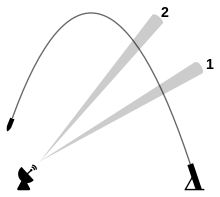This article has multiple issues. Please help improve it or discuss these issues on the talk page. (Learn how and when to remove these messages)
|


A counter-battery radar or weapon tracking radar is a radar system that detects artillery projectiles fired by one or more guns, howitzers, mortars or rocket launchers and, from their trajectories, locates the position on the ground of the weapon that fired it.[1]: 5–18 Such radars are a subclass of the wider class of target acquisition radars.
Early counter-battery radars were generally used against mortars, whose lofted trajectories were highly symmetrical and allowed easy calculation of the launcher's location. Starting in the 1970s, digital computers with improved calculation capabilities allowed more complex trajectories of long-range artillery to also be determined. Normally, these radars would be attached to friendly artillery units or their support units, allowing them to quickly arrange counter-battery fire.[1]: 5–15
With the aid of modern communications systems, the information from a single radar can be rapidly disseminated over long distances. This allows the radar to notify multiple batteries as well as provide early warning to the friendly targets.[2] Modern counter-battery radar can locate hostile batteries up to about 50 kilometres (31 mi; 27 nmi) away depending on the radar's capabilities and the terrain and weather. Some counter-battery radars can also be used to track the fire of friendly artillery and calculate corrections to adjust its fire onto a particular place, but this is usually a secondary mission objective.[1]: C-1
Radar is the most recently developed means of locating hostile artillery. The emergence of indirect fire in World War I saw the development of sound ranging, flash spotting and aerial reconnaissance, both visual and photographic. Radars, like sound ranging and flash spotting, require hostile guns, etc., to fire before they can be located.
- ^ a b c ARMY FM 3-09.12 (FM 6-121) MCRP 3-16.1A Tactics, Techniques, and Procedures for FIELD ARTILLERY TARGET ACQUISITION (PDF). US Army. 2002. Archived from the original (PDF) on 26 December 2014. Retrieved 1 July 2014.
- ^ "EURO-ART COBRA Counter Battery Radar". EURO-ART GmbH. Archived from the original on 30 July 2014. Retrieved 17 October 2014.